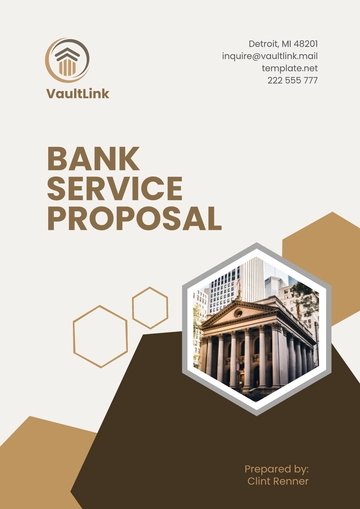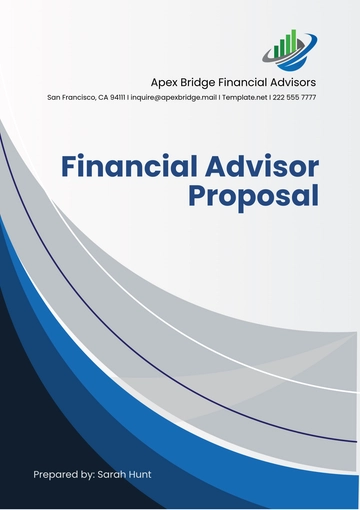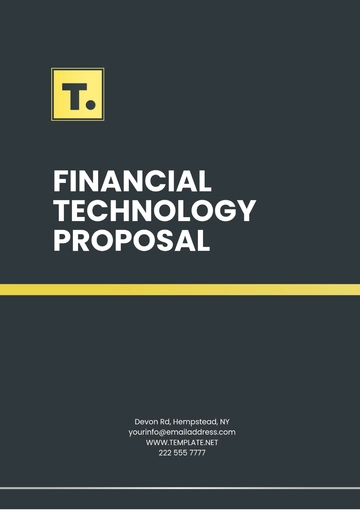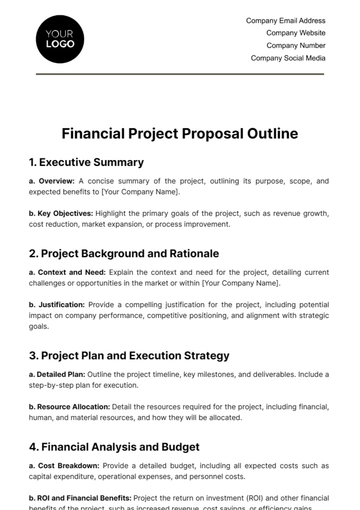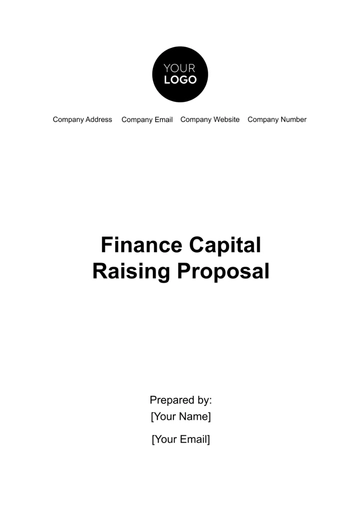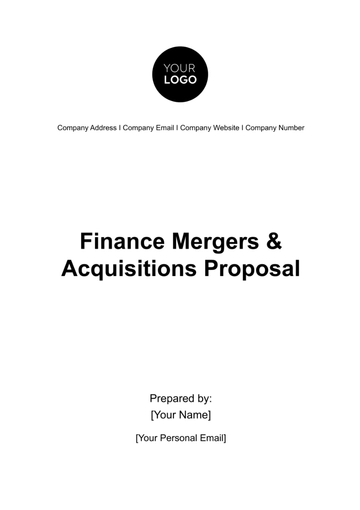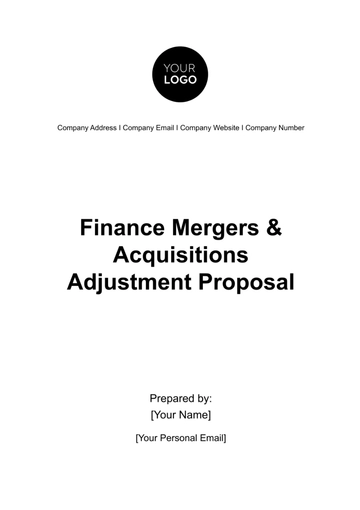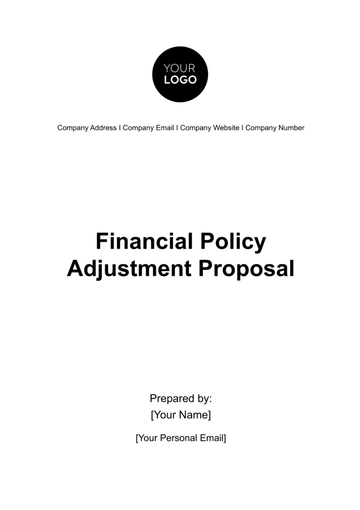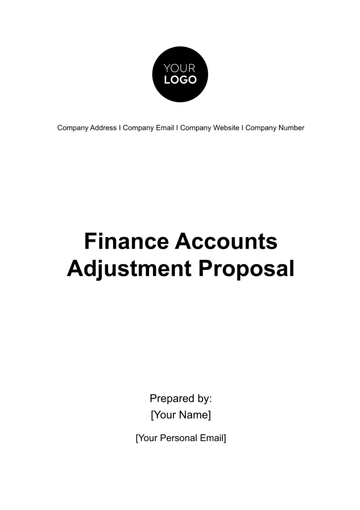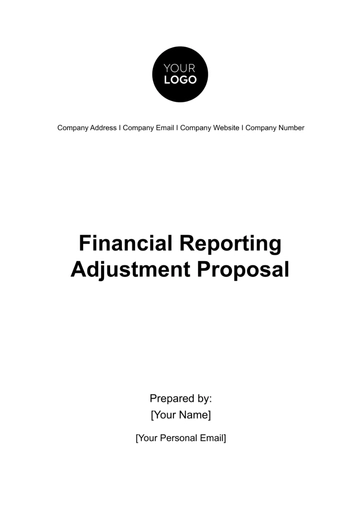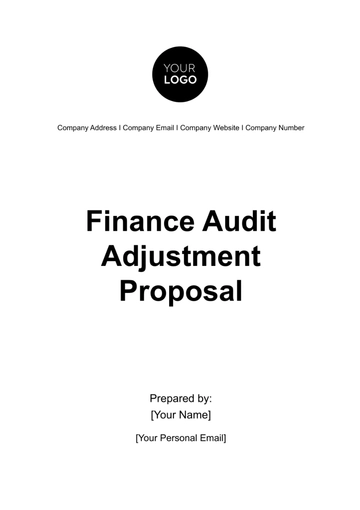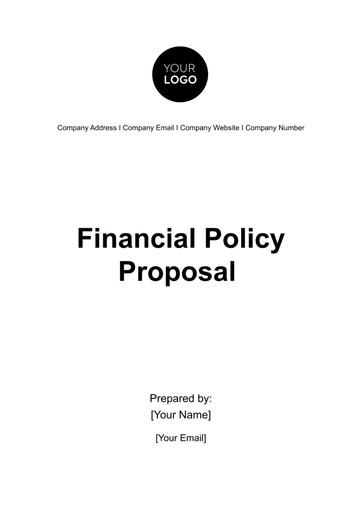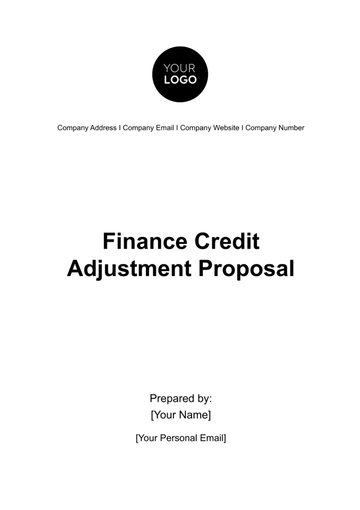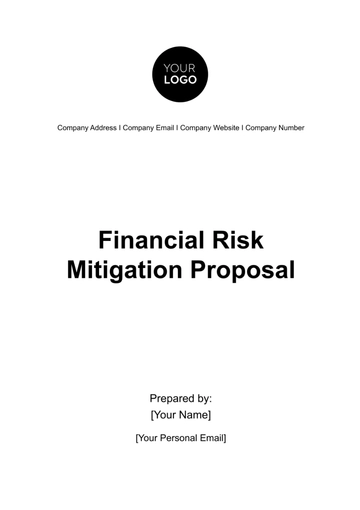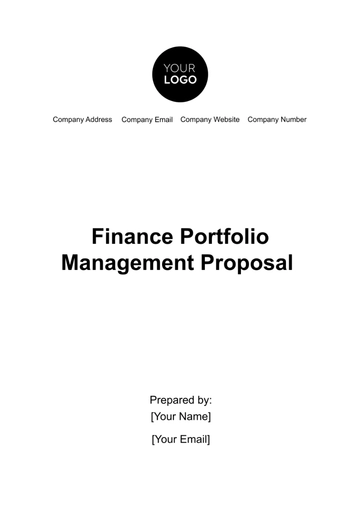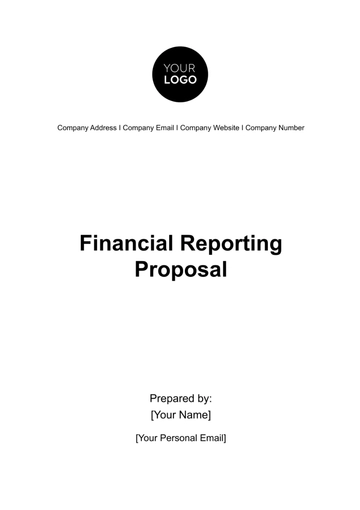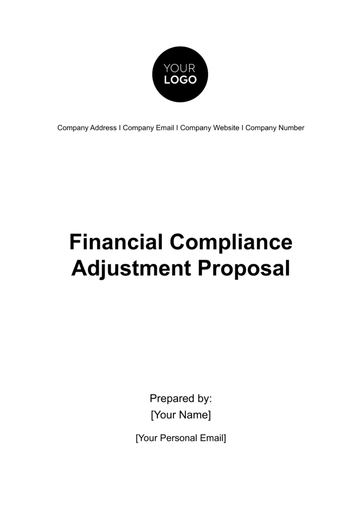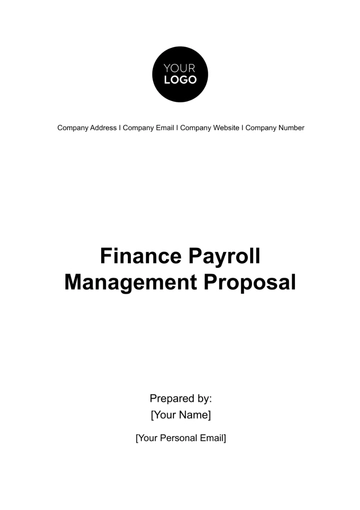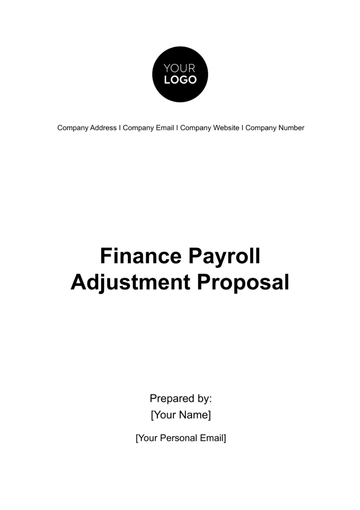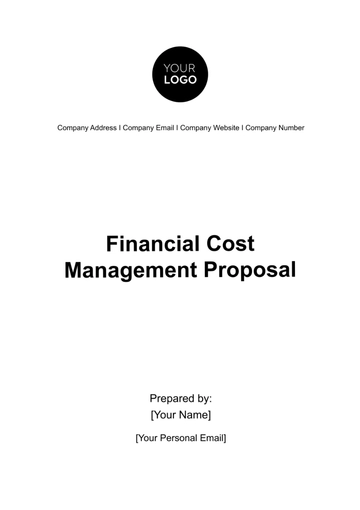Free Finance Portfolio Management Proposal
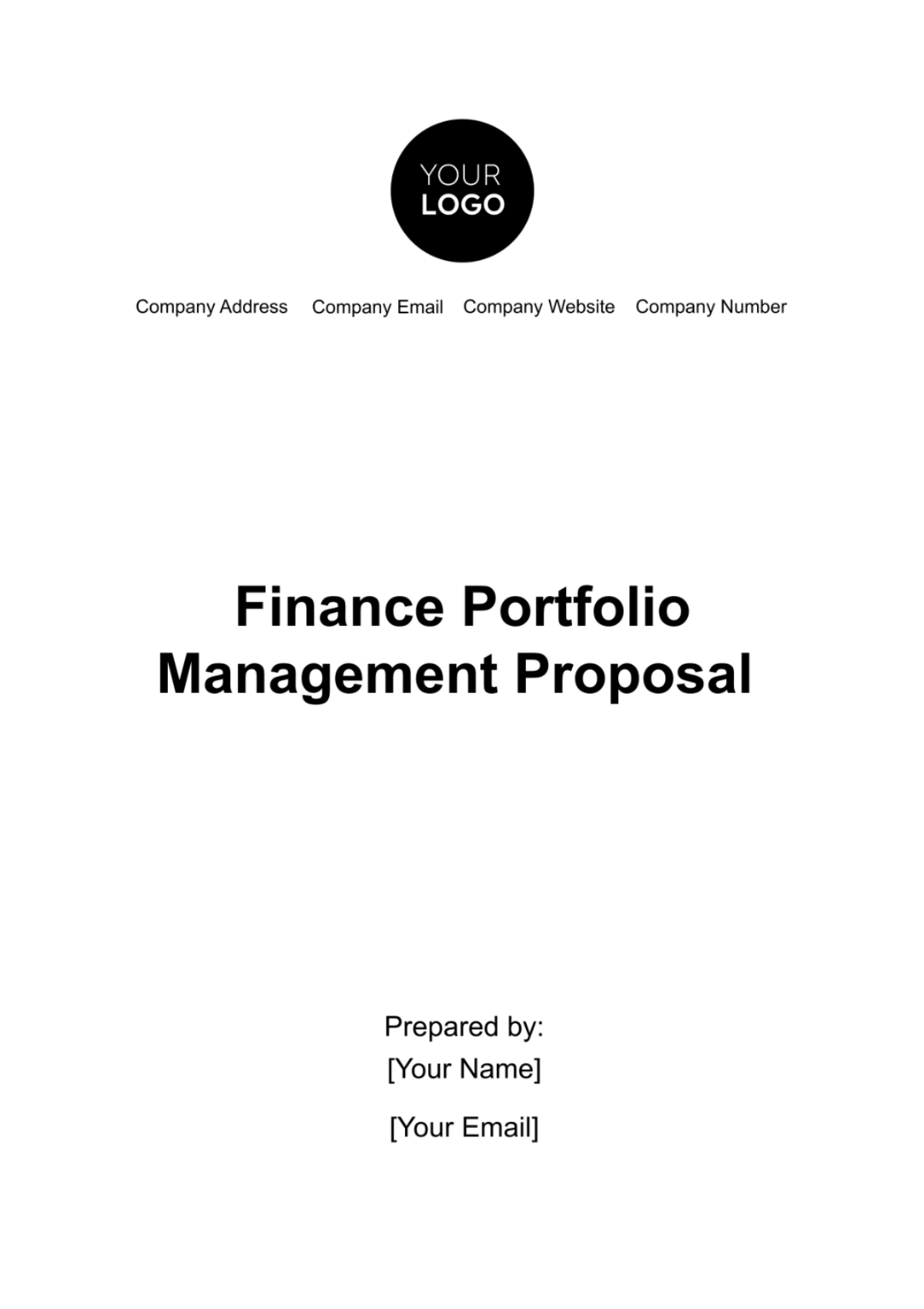
Executive Summary
This comprehensive proposal is designed to strategically guide the company's Finance Investment Analysis and Portfolio Management. Our objective is to optimize the financial portfolio, focusing on robust growth, sustainable returns, and effective risk mitigation. The core of our strategy revolves around a diversified investment approach, targeting a blend of traditional and innovative asset classes.
Key Highlights:
Targeted Asset Growth: Aiming for a progressive year-on-year growth in asset value, targeting an overall increase of 25% over the next five years.
Risk-Adjusted Returns: Prioritizing investments that offer optimal returns for their respective risk levels.
Dynamic Asset Allocation: Flexibility in asset allocation based on market trends and economic forecasts.
Projected Financial Growth (5-Year Plan):
Year | Projected Asset Growth | Return on Investment |
1 | 3% | 5% |
2 | 5% | 6% |
3 | 7% | 7% |
4 | 9% | 8% |
5 | 10% | 9% |
The proposal outlines a detailed strategy encompassing asset allocation, sector-specific investment plans, risk management tactics, and performance monitoring protocols.
Investment Philosophy
Core Principles
Our investment philosophy is rooted in three core principles: Diversification, Risk Tolerance, and Market Adaptability. We believe that a well-diversified portfolio reduces risk and enhances potential returns. Our risk tolerance is aligned with the company's overall financial goals and market conditions. We also emphasize the importance of being adaptable to market changes and economic signals.
Risk Management
We adopt a multi-faceted approach to risk management, incorporating both traditional methods and innovative techniques.
Diversification Strategy: Investments are spread across various asset classes, industries, and geographic locations to minimize risk.
Regular Risk Assessments: Frequent analysis of market volatility, economic indicators, and portfolio performance.
Risk Management Framework:
Strategy | Description | Implementation Frequency |
Portfolio Diversification | Spread investments to mitigate risk | Ongoing |
Market Analysis | Regular analysis of market trends | Monthly |
Stress Testing | Scenario analysis under various market conditions | Quarterly |
Growth Orientation
Our growth strategy is focused on identifying and capitalizing on long-term growth opportunities.
Emerging Markets and Sectors: Investing in markets and sectors with high potential for growth.
Innovation-Driven Investments: Allocating a portion of the portfolio to innovative industries and technologies.
Growth Strategy Overview:
Investment Area | Description | Expected Growth Impact |
Emerging Markets | High potential markets with growing economies | High |
Technology Sector | Investments in cutting-edge technologies | Moderate to High |
Sustainable Investments | Eco-friendly and sustainable business models | Moderate |
In summary, our investment philosophy is designed to achieve a harmonious balance between aggressive growth targets and prudent risk management, ensuring the company's financial portfolio is robust, dynamic, and poised for sustainable growth.
Portfolio Structure
The portfolio structure is meticulously designed to balance growth, income, and risk management. This structure will dynamically evolve based on market conditions and company objectives.
Asset Allocation
Our strategic asset allocation is diversified across various asset classes to optimize returns and manage risk effectively.
Detailed Asset Allocation:
Asset Class | Allocation Percentage | Objective | Risk Level |
Equities | 50% | Capital Growth | High |
Bonds | 30% | Income & Stability | Moderate |
Alternative Investments | 10% | Diversification & Growth | High |
Cash and Equivalents | 10% | Liquidity & Safety | Low |
Sector Distribution
Investments are spread across several sectors to exploit various growth potentials and mitigate sector-specific risks.
Sector Allocation Table:
Sector | Allocation Percentage | Rationale |
Technology | 20% | High growth potential, innovation-driven |
Healthcare | 15% | Stability, essential services |
Consumer Goods | 15% | Consistent demand, resilience |
Financial Services | 10% | Economic growth, dividend income |
Industrials | 10% | Infrastructure growth, global expansion |
Others | 30% | Diversification across emerging sectors |
Investment Strategies
Our investment strategies are crafted to align with the portfolio structure, focusing on maximizing returns and managing risks in each asset class.
Equity Investments
Equity investments form the backbone of our growth strategy, focusing on a mix of stable, large-cap stocks and high-potential small to mid-cap stocks.
Equity Investment Approach:
Blue-Chip Stocks: Stable, well-established companies with consistent performance.
Growth Stocks: Companies with high growth potential in emerging sectors.
International Exposure: Diversification through global market investments.
Fixed Income Investments
Our bond investments aim to provide steady income while preserving capital, focusing on a mix of government and high-quality corporate bonds.
Fixed Income Strategy:
Government Bonds: Stability and risk mitigation.
Corporate Bonds: Higher yields with moderate risk.
Maturity Laddering: Diversifying bond maturities to manage interest rate risk and provide regular income.
Alternative Investments
Alternative investments are aimed at portfolio diversification and enhancing returns, including investments in real estate, private equity, and commodities.
Alternative Investment Focus:
Investment Type | Strategy | Expected Benefit |
Real Estate | Income-generating properties | Steady income, capital appreciation |
Private Equity | Investments in non-public companies | High growth potential |
Commodities | Diversification, hedge against inflation | Portfolio balance, risk management |
Risk Management
The Risk Management strategy is pivotal in safeguarding the portfolio against unforeseen market dynamics and ensuring long-term sustainability.
Risk Assessment and Mitigation
Our approach to risk assessment is multifaceted, focusing on identifying, analyzing, and mitigating risks.
Risk Management Techniques:
Technique | Description | Frequency |
Portfolio Diversification | Spreading investments to reduce specific risks | Ongoing |
Market Analysis | Analyzing market trends for proactive risk measures | Bi-weekly |
Sensitivity Analysis | Assessing portfolio response to market changes | Quarterly |
Stress Testing | Simulating extreme market scenarios | Bi-annually |
Regulatory Compliance and Ethical Standards
Compliance with financial regulations and adherence to ethical investment standards are core to our risk management philosophy.
Compliance Strategies:
Regular Audits: Ensuring compliance with financial regulations and internal policies.
Ethical Investment: Excluding investments in industries that pose high ethical or regulatory risks.
Liquidity Management
Maintaining adequate liquidity is crucial for meeting short-term obligations and capitalizing on new investment opportunities.
Liquidity Strategies:
Cash Reserves: Maintaining a portion of the portfolio in highly liquid assets.
Credit Facilities: Access to credit lines for unforeseen liquidity needs.
Performance Monitoring
Performance monitoring is essential for evaluating the effectiveness of our investment strategies and making necessary adjustments.
Quarterly Reviews
Quarterly reviews are conducted to assess portfolio performance against benchmarks and industry standards.
Key Performance Indicators:
Indicator | Description |
Return on Investment | Measures the gain or loss relative to investment |
Alpha | Performance relative to a benchmark |
Beta | Portfolio's volatility compared to the market |
Annual Audit
An in-depth annual audit provides a comprehensive review of the portfolio's performance, risk exposure, and strategy effectiveness.
Annual Audit Focus Areas:
Performance Analysis: Comparing actual returns against projected returns.
Risk Exposure Review: Evaluating the portfolio's risk profile and risk management efficacy.
Strategy Assessment: Analyzing the success of investment strategies and making adjustments for the upcoming year.
Continuous Monitoring and Reporting
Continuous monitoring and regular reporting keep stakeholders informed and ensure timely decision-making.
Monitoring and Reporting Tools:
Real-time Dashboards: Providing ongoing insights into portfolio performance.
Monthly Reports: Detailed reports on portfolio activities and market trends.
Financial Projections
The financial projections are designed to provide a forward-looking estimate of the portfolio's performance over the next five years, incorporating our investment strategies, risk management, and market analysis.
Five-Year Financial Forecast
This forecast outlines the expected annual growth in assets and projected returns, factoring in our diversified investment approach and market predictions.
Year | Projected Asset Growth | Return on Investment | Expected Inflation Rate |
1 | 4% | 5.5% | 2% |
2 | 6% | 6.5% | 2.5% |
3 | 8% | 7.5% | 2.5% |
4 | 10% | 8.5% | 3% |
5 | 12% | 9.5% | 3% |
Revenue and Profit Projections
Revenue projections are based on the expected performance of our investments, while profit projections consider operational costs and taxes.
Projected Revenue and Profit:
Year | Projected Revenue ($M) | Projected Profit ($M) | Profit Margin |
1 | 20 | 5 | 25% |
2 | 22 | 6 | 27% |
3 | 25 | 7.5 | 30% |
4 | 28 | 9 | 32% |
5 | 32 | 11 | 34% |
Risk Adjusted Returns
The risk-adjusted return projections consider the portfolio's risk profile, providing a realistic expectation of returns.
Risk-Adjusted Return Projections:
Year | Expected Return | Risk Level | Adjusted Return |
1 | 5.5% | Moderate | 4.5% |
2 | 6.5% | Moderate | 5.0% |
3 | 7.5% | High | 6.0% |
4 | 8.5% | High | 6.5% |
5 | 9.5% | High | 7.0% |
Conclusion
In conclusion, this portfolio management proposal presents a strategic and well-structured approach to achieving robust financial growth and ensuring long-term sustainability. Our diversified investment strategy, coupled with rigorous risk management and continuous performance monitoring, positions us to navigate market volatilities effectively and capitalize on growth opportunities.
Key Takeaways:
Balanced Approach: Combining growth, income, and preservation strategies to optimize portfolio performance.
Dynamic Adaptation: Flexibility to adjust strategies in response to market changes and economic indicators.
Long-Term Vision: Focused on achieving sustainable growth and value creation over the long term.
Future Considerations:
Evolving Market Trends: Continuously adapting to global economic changes and market trends.
Technological Advancements: Leveraging technology for better market analysis and investment decisions.
Stakeholder Engagement: Keeping stakeholders informed and involved in key investment decisions.
This proposal serves as a roadmap to guide our financial portfolio management, aiming to achieve the company's financial objectives while adhering to our core values of integrity, transparency, and excellence.
- 100% Customizable, free editor
- Access 1 Million+ Templates, photo’s & graphics
- Download or share as a template
- Click and replace photos, graphics, text, backgrounds
- Resize, crop, AI write & more
- Access advanced editor
Present your portfolio management services effectively with the Finance Portfolio Management Proposal Template from Template.net. This editable, customizable template is perfect for financial advisors proposing services to clients. It outlines investment strategies, management techniques, and client benefits, helping to communicate expertise and build trust in your portfolio management capabilities.
You may also like
- Business Proposal
- Research Proposal
- Proposal Request
- Project Proposal
- Grant Proposal
- Photography Proposal
- Job Proposal
- Budget Proposal
- Marketing Proposal
- Branding Proposal
- Advertising Proposal
- Sales Proposal
- Startup Proposal
- Event Proposal
- Creative Proposal
- Restaurant Proposal
- Blank Proposal
- One Page Proposal
- Proposal Report
- IT Proposal
- Non Profit Proposal
- Training Proposal
- Construction Proposal
- School Proposal
- Cleaning Proposal
- Contract Proposal
- HR Proposal
- Travel Agency Proposal
- Small Business Proposal
- Investment Proposal
- Bid Proposal
- Retail Business Proposal
- Sponsorship Proposal
- Academic Proposal
- Partnership Proposal
- Work Proposal
- Agency Proposal
- University Proposal
- Accounting Proposal
- Real Estate Proposal
- Hotel Proposal
- Product Proposal
- Advertising Agency Proposal
- Development Proposal
- Loan Proposal
- Website Proposal
- Nursing Home Proposal
- Financial Proposal
- Salon Proposal
- Freelancer Proposal
- Funding Proposal
- Work from Home Proposal
- Company Proposal
- Consulting Proposal
- Educational Proposal
- Construction Bid Proposal
- Interior Design Proposal
- New Product Proposal
- Sports Proposal
- Corporate Proposal
- Food Proposal
- Property Proposal
- Maintenance Proposal
- Purchase Proposal
- Rental Proposal
- Recruitment Proposal
- Social Media Proposal
- Travel Proposal
- Trip Proposal
- Software Proposal
- Conference Proposal
- Graphic Design Proposal
- Law Firm Proposal
- Medical Proposal
- Music Proposal
- Pricing Proposal
- SEO Proposal
- Strategy Proposal
- Technical Proposal
- Coaching Proposal
- Ecommerce Proposal
- Fundraising Proposal
- Landscaping Proposal
- Charity Proposal
- Contractor Proposal
- Exhibition Proposal
- Art Proposal
- Mobile Proposal
- Equipment Proposal
- Student Proposal
- Engineering Proposal
- Business Proposal

